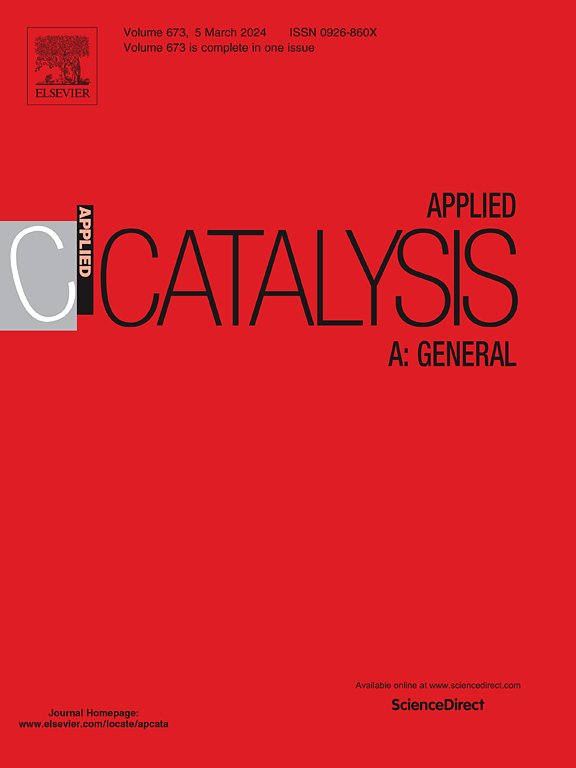Rh/γ-Al2O3催化剂在二甲基甲苯-2,4-二氨基甲酸酯选择性加氢反应中的尺寸效应
IF 4.7
2区 化学
Q2 CHEMISTRY, PHYSICAL
引用次数: 0
摘要
二甲基甲苯-2,4-二氨基甲酸酯(TDC)选择性加氢合成甲基环己基-2,4-二氨基甲酸酯(HTDC)是非光气合成甲基环己烷-2,4-二异氰酸酯(HTDI)的重要工艺。制备了Rh粒径为1.8 ~ 6.7 nm的Rh/γ-Al2O3催化剂,研究了粒径对TDC选择性加氢反应的影响。结果表明:Rh/γ-Al2O3的催化活性随着Rh粒径的增大而单调增加;这证明了Rh/γ-Al2O3催化剂具有负尺寸效应或抗拮抗结构敏感性。通过表征,我们发现Rh的几何性质是影响催化剂活性的主要因素。结合所建立的Rh粒子模型,推测Rh(111)在TDC的选择性加氢中起主要作用,阶地位点有利于促进TDC的吸附。粒径效应的研究可为设计和制备高效的rh基TDC选择性加氢催化剂提供指导。本文章由计算机程序翻译,如有差异,请以英文原文为准。
Size effect of Rh/γ-Al2O3 catalyst in selective hydrogenation of dimethyl toluene-2,4-dicarbamate
The selective hydrogenation of dimethyl toluene-2,4-dicarbamate (TDC) to methyl cyclohexyl-2,4-dicarbamate (HTDC) is an important process for non-phosgene synthesis of methylcyclohexane-2,4-diisocyanate (HTDI). We prepared Rh/γ-Al2O3 catalysts with an Rh particle size of 1.8–6.7 nm and studied size effect on TDC selective hydrogenation. The results showed that the catalytic activities of Rh/γ-Al2O3 increase monotonously with increasing Rh particle size. This demonstrated that Rh/γ-Al2O3 catalyst dedicates a negative size effect or an antipathetic structure sensitivity. Based on the characterization, we found that the geometric property of Rh is the main factor affecting the activity of catalyst. Combined with the proposed Rh particle model, it was inferred that the Rh (111) plays a major role in the TDC selective hydrogenation and the terrace sites are beneficial to promote the adsorption of TDC. The study on size effect can provide a guidance for the design and preparation of highly efficient Rh-based catalysts for TDC selective hydrogenation.
求助全文
通过发布文献求助,成功后即可免费获取论文全文。
去求助
来源期刊

Applied Catalysis A: General
化学-环境科学
CiteScore
9.00
自引率
5.50%
发文量
415
审稿时长
24 days
期刊介绍:
Applied Catalysis A: General publishes original papers on all aspects of catalysis of basic and practical interest to chemical scientists in both industrial and academic fields, with an emphasis onnew understanding of catalysts and catalytic reactions, new catalytic materials, new techniques, and new processes, especially those that have potential practical implications.
Papers that report results of a thorough study or optimization of systems or processes that are well understood, widely studied, or minor variations of known ones are discouraged. Authors should include statements in a separate section "Justification for Publication" of how the manuscript fits the scope of the journal in the cover letter to the editors. Submissions without such justification will be rejected without review.
 求助内容:
求助内容: 应助结果提醒方式:
应助结果提醒方式:


